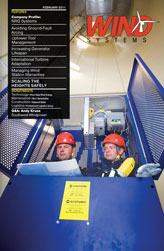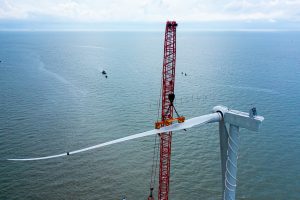Wind towers founded on spread footings may settle as a result of loose bearing soils either not identified during the preconstruction geotechnical exploration or remaining after inadequate subgrade preparation. Loose granular soils may also be susceptible to liquefaction during a seismic event, which may result in excessive settlement or complete foundation failure. When wind towers are founded on loose granular soils, cement grouting may be the correct solution for providing long-term support. It is also used to solidify granular soils beneath a structure for both underpinning and excavation support when an adjacent excavation is to take place. Cement grouting has also been used to stabilize a fractured rock mass around cylinder-type wind tower foundations with post-tensioned anchor bolts.
Cement grouting, also known as microfine cement grouting, is a permeation grouting technique that binds granular soils into a cemented mass, by permeation with a low viscosity cement grout. The grout is injected under pressure through previously installed pipes. The grouted soil has increased strength and stiffness, and reduced permeability. Common cement grouting applications are to underpin existing foundations, create excavation support walls, create water cutoff walls, and fill cracks in rock formations, particularly to cut off water flow paths below dams. Cement grouting is available as a design-build service by specialty contractors. A thorough geotechnical investigation should be performed prior to design of a cement grouting program to help to ensure proper injection hole geometry and grout selection. Cement grouts can consist of standard Portland cement or materials known as microfine cements which consist of finely ground slag and Portland cement that is mixed with water and a dispersant to aid permeation. Standard cement particles can permeate course sand and microfine cements are necessary to permeate medium and fine sand. The equipment is relatively small, and therefore is suitable for use on sites with restricted access.

Cement grout can either be injected through a pipe drilled into the soil or, when grouting rock formations, through an open hole drilled in rock. Packers are often used to isolate sections of the drilled hole to help assure proper grout distribution. When treating sand, injection pipes known as Tube-a-manchette (TAM) pipes are used to carefully control the injection location. TAM pipes are typically two-inch diameter steel pipes with injection ports every few feet along the length of the pipe. Rubber sleeves (manchettes) cover each injection port and serve as one-way valves that open during injection and collapse onto the ports after injection. The TAM pipes are installed in boreholes in a designed pattern beneath a foundation to allow injection beneath the entire foundation footprint. Depending on site access, TAM pipe inclinations can range from vertical to horizontal to create a treatment zone. Once the TAM pipes have been inserted into the borehole, the space between the TAM pipe and borehole wall (annulus) is filled with a weak but stiff grout that seals and stabilizes the borehole and holds the TAM pipe in position. A pneumatic packer is then pushed into the TAM to a specified injection point. Rubber seals at each end of the packer are hydraulically inflated to isolate the injection port. The initial pressure of the cement grout breaks through the annulus, permitting it access to the soil.
The volume of cement grout needed to solidify a zone of granular soil is calculated by predicting the shape of the grout flow from the injection point determined by the subsurface conditions. In uniform granular soils, the grout typically flows radially from each port to create a spherical grouted shape. Based on a spherical flow model and the soil void ratio, the required maximum design volume can be calculated.
An effective quality control program requires that all stages be monitored and fully documented. Installation of the sleeve port pipes is monitored to ensure proper alignment. An experienced grout technician should monitor the grout flow meters and pressure gauges during grout injection and record the injection data for each location: pipe number, date, sleeve number and elevation, grout volume, and pressure and flow readings. A geotechnical engineer should review the data to verify the formation and stability of the grouted mass. In use since the late 1800s, wind tower construction can take advantage of this effective alternative to complete reconstruction of the foundation system.


































